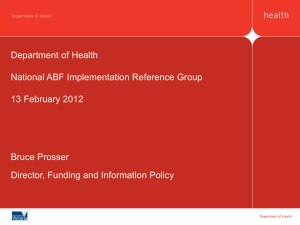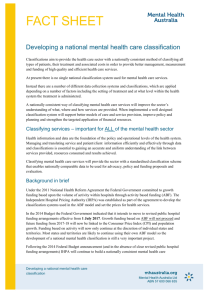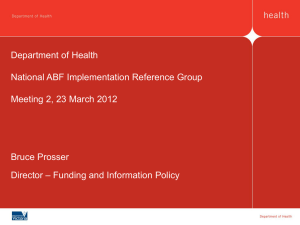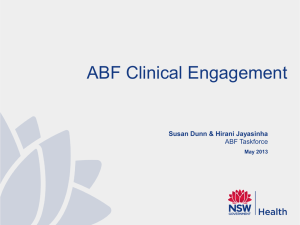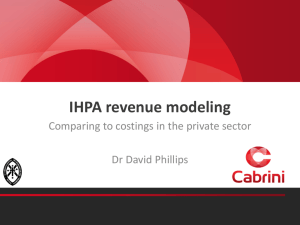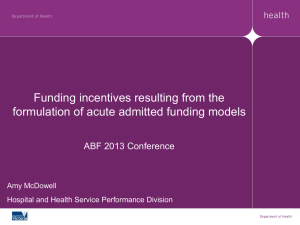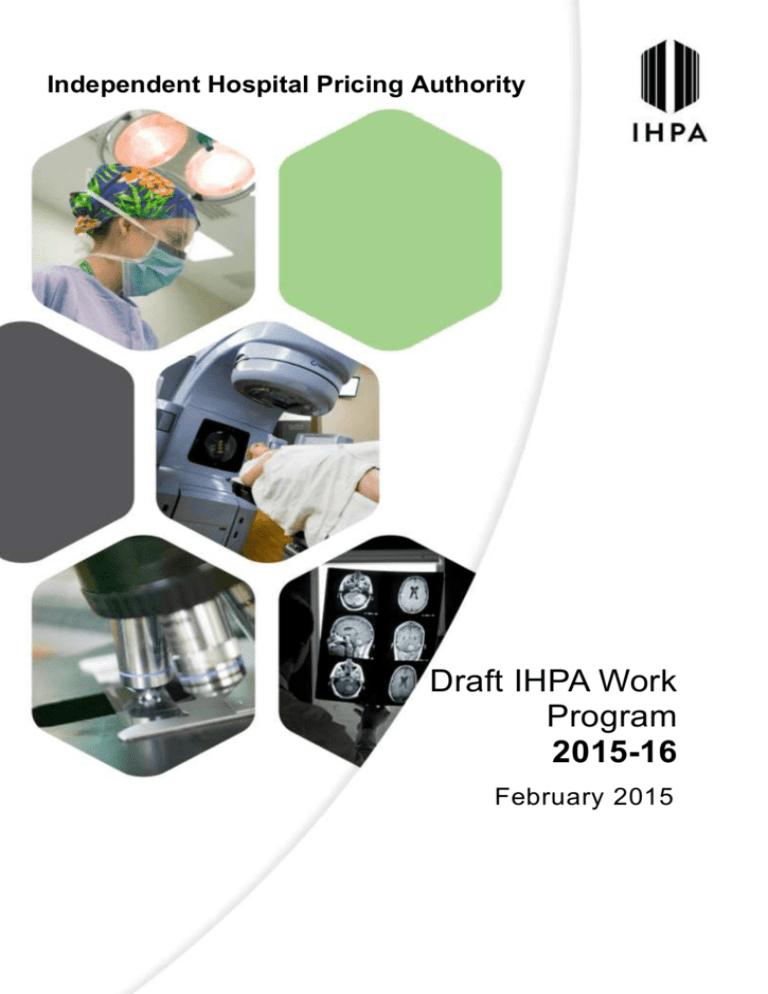
Independent Hospital Pricing Authority
Draft IHPA Work
Program
2015-16
February 2015
Work Program 2015-16
© Commonwealth of Australia 2015
This work is copyright. You may download, display, print and reproduce the whole or part of
this work in unaltered form for your own personal use or, if you are part of an organisation,
for internal use within your organisation, but only if you or your organisation do not use the
reproduction for any commercial purpose and retain this copyright notice and all disclaimer
notices as part of that reproduction. Apart from rights to use as permitted by the Copyright
Act 1968 or allowed by this copyright notice, all other rights are reserved and you are not
allowed to reproduce the whole or any part of this work in any way (electronic or otherwise)
without first being given the specific written permission from Independent Hospital Pricing
Authority to do so.
Page 1 of 31
IHPA Work Program 2015-16
Table of Contents
Abbreviations and acronyms ............................................................................................. 3
1.
Introduction .............................................................................................................. 5
1.1 Background ..................................................................................................................... 5
1.2 Purpose ........................................................................................................................... 5
1.3 Objectives ....................................................................................................................... 5
1.4 Review ............................................................................................................................ 6
2. IHPA Work Program 2015-16 .......................................................................................... 7
Overview ............................................................................................................................... 7
Program objective 1 ............................................................................................................ 8
2016-17 Pricing Framework development ............................................................................. 8
Program objective 2 .......................................................................................................... 11
Determination of the NEP and NEC for public hospital services .......................................... 11
Program objective 3 .......................................................................................................... 14
ABF classification system development and revision ........................................................... 14
Program objective 4 .......................................................................................................... 18
Development of data requirements and standards .............................................................. 18
Program objective 5 .......................................................................................................... 21
Public hospital services costing development ...................................................................... 21
Program objective 6 .......................................................................................................... 24
Support ABF research and education .................................................................................. 24
Program objective 7 .......................................................................................................... 27
Management of the international sales of the AR-DRG system ........................................... 27
Program objective 8 .......................................................................................................... 28
Resolution of cross-border and cost-shifting disputes between jurisdictions ........................ 28
Appendix 1 – Extract of Section 225 of the Act ............................................................... 29
Appendix 2 – Alignment of the IHPA Work Program 2015-16 to the functions
prescribed in the Act ......................................................................................................... 30
Independent Hospital Pricing Authority
Page 2 of 31
IHPA Work Program 2015-16
Abbreviations and acronyms
ABF
Activity Based Funding
ACHI
Australian Classification of Health Interventions
AHPCS
Australian Hospital Patient Costing Standards
AIHW
Australian Institute of Health and Welfare
AMHCC
Australian Mental Health Care Classification
AN-SNAP
Australian National Subacute and Non-Acute Patient
Classification
APC
Admitted Patient Care
ARCBS
Australian Red Cross Blood Service
AR-DRG
Australian Refined Diagnosis Related Group
CAC
Clinical Advisory Committee
CALD
Culturally and Linguistically Diverse
CHC
Council of Australian Governments Health Council
COAG
Council of Australian Governments
DSS
Data Set Specification
EDW
Enterprise Data Warehouse
GEM
Geriatric Evaluation and Management
ICD-10-AM
Australian Modification of the International Statistical
Classification of Diseases, 10th revision
ICU
Intensive Care Unit
IFR
Independent Financial Review
IHPA
Independent Hospital Pricing Authority
Jurisdictions
Commonwealth, states and territories
LHN
Local Hospital Network or the equivalent
MHC
Mental Health Care
NBA
National Blood Authority
NEC
National Efficient Cost
NEP
National Efficient Price
NHCDC
National Hospital Cost Data Collection
NHIPPC
National Health Information and Performance Principal
Committee
NHISSC
National Health Information Standards and Statistics Committee
NHRA
National Health Reform Agreement 2011
NMDS
National Minimum Data Set
PHE
Public Hospitals Establishments
Pricing Framework
Pricing Framework for Australian Public Hospital Services
Independent Hospital Pricing Authority
Page 3 of 31
IHPA Work Program 2015-16
The Act
National Health Reform Act 2011
The Commission
The Australian Commission on Safety and Quality in Health
Care
TTR
Teaching, Training and Research
UDGs
Urgency Disposition Groups
URGs
Urgency Related Groups
Independent Hospital Pricing Authority
Page 4 of 31
IHPA Work Program 2015-16
1.
Introduction
1.1 Background
The Independent Hospital Pricing Authority (IHPA) is an independent Commonwealth
authority established under Commonwealth legislation as part of the National Health Reform
Agreement (NHRA) reached by the Council of Australian Governments (COAG) in
August 2011. The NHRA sets out the intention of the Commonwealth and state and territory
governments to work in partnership to improve health outcomes for all Australians.
IHPA is a key element of the NHRA, and is charged with determining the National Efficient
Price (NEP) and National Efficient Cost (NEC) for public hospital services, allowing for the
national introduction of Activity Based Funding (ABF). From 1 July 2012, the Commonwealth
has used the NEP to determine the Commonwealth funding to Local Hospital Networks
(LHNs). The implementation of ABF will improve transparency, and strengthen incentives for
efficiency in the delivery of public hospital services.
On 13 May 2014, the Commonwealth Treasurer delivered the Commonwealth Government’s
Budget 2014-15. The Commonwealth Government announced its intention to work with
states and territories during 2014-15 with the intention to create a new Health Productivity
and Performance Commission. Subject to consultation, the new Health Productivity and
Performance Commission would be formed by merging the functions of the Australian
Commission on Safety and Quality in Health Care, the Australian Institute of Health and
Welfare, IHPA, the National Health Performance Authority, the National Health Funding Body
and the Administrator of the National Health Funding Pool.
Whilst the Government undertakes these consultations, IHPA will continue to deliver the
program of work laid out in the IHPA Work Program, including the Determination of the
2016-17 NEP (NEP16) and NEC (NEC16).
IHPA reinforces its commitment to continue to consult and collaborate with jurisdictions on
the implementation of the components of the NHRA that relate to IHPA through the
Jurisdictional Advisory Committee.
In this document, ‘Pricing Authority’ refers to the governing members and ‘IHPA’ refers to the
agency.
1.2 Purpose
As prescribed in Section 225 of the National Health Reform Act 2011 (the Act), the objectives
of the IHPA Work Program are to:
set out IHPA’s work program for the coming year; and
invite interested persons (including states and territories) to make submissions to the
Pricing Authority about the work program up to 30 days after publication.
An extract of Section 225 of the Act is attached at Appendix 1.
1.3 Objectives
The objectives of publishing and calling for public submissions on the IHPA Work Program
are to:
enhance focus on the equitable funding of public hospitals
improve efficiency, accountability and transparency across the public health care
system, and
drive financial sustainability of public hospital services into the future.
Independent Hospital Pricing Authority
Page 5 of 31
IHPA Work Program 2015-16
1.4 Review
The Work Program will be revised and published each financial year in accordance with the
Act. IHPA will report on the progress of its Work Program in its Annual Report.
At the end of each period IHPA will evaluate its performance against the Work Program.
Independent Hospital Pricing Authority
Page 6 of 31
IHPA Work Program 2015-16
2. IHPA Work Program 2015-16
Overview
The IHPA Work Program for 2015-16 encompasses the following:
1.
Development of the Pricing Framework for Australian Public Hospital Services
2016-17
2.
Determination of the NEP and NEC for public hospital services
3.
ABF classification system development and revision
4.
Development of data requirements and standards
5.
Public hospital services costing development
6.
Support of ABF research and education
7.
Management of the international sales of the Australian Refined Diagnosis Related
Group (AR-DRG) system
8.
Resolution of cross-border disputes and assessment of cost-shifting disputes
between jurisdictions.
A description of each of these program objectives, the deliverables and indicative timeframes
for completion are outlined in this document.
These program objectives have been aligned to the functions of IHPA, as prescribed in
Section 131 of the Act. An extract of Section 131 of the Act is attached at Appendix 2.
Independent Hospital Pricing Authority
Page 7 of 31
Work Program 2015-16
Program objective 1
2016-17 Pricing Framework development
(a) Development of the Pricing Framework for Australian Public Hospital Services
(Pricing Framework) 2016-17
IHPA will develop the Pricing Framework outlining the principles, scope and methodology to
be adopted by IHPA in the setting of the NEP and NEC for public hospital services in
2016-17. The Pricing Framework forms the policy basis for the NEP and NEC
determinations.
IHPA will publish the Consultation Paper on the Pricing Framework for Australian Public
Hospital Services 2016-17 and call for public submissions. IHPA will provide the draft Pricing
Framework 2016-17 to health ministers by 30 September 2015 with health ministers having
a statutory 45 days to provide comments to IHPA. After consideration of comments from
health ministers, IHPA will publish the final Pricing Framework 2016-17 by
30 November 2015 for adoption in the following financial year.
Deliverables
Timeframes
Publication of the Consultation Paper on the Pricing Framework
for Australian Public Hospital Services 2016-17 and call for public
submissions
30 June 2015
Provision of the draft Pricing Framework for Australian Public
Hospital Services 2016-17 to health ministers for 45 day
comment period
30 September 2015
Publication of the final Pricing Framework for Australian Public
Hospital Services 2016-17 on IHPA website
30 November 2015
Independent Hospital Pricing Authority
Page 8 of 31
Work Program 2015-16
(b) Pricing for quality and safety in the delivery of public hospital services
The NHRA requires that IHPA, in setting the NEP, must have “regard to ensuring reasonable
access to public hospital services, clinical safety and quality, efficiency and effectiveness
and financial sustainability of the public hospital system” (clause B12(a)).
The Australian Commission on Safety and Quality in Health Care (the Commission) and
IHPA are working together to consider options for their respective governing bodies on the
most appropriate potential approaches to ensuring safety and quality in the provision of
health care services.
In 2014-15, IHPA and the Commission progressed work on:
Developing and piloting ways in which data and information routinely generated in
Australian hospitals could be provided to clinical teams in the hospital environment to
promote improvement in safety and quality; specifically, a proof of concept to test the
draft national set of high-priority hospital complications in selected Australian
hospitals; and
The requirements and feasibility of introducing best-practice pricing in Australian
public hospitals with a specific focus on hip fracture patients.
An appropriate mechanism and format for providing safety and quality data to clinical
teams and hospital leaders to drive quality improvement in ways that support
implementation of best-practice pricing in priority clinical areas, with a focus on hip
fracture patients.
The findings of this work will be reported to the agencies’ governing bodies.
In 2015-16, IHPA will provide advice to the Pricing Authority on potential approaches to
incorporate safety and quality into public hospital services pricing.
Deliverables
Timeframes
Results of the work on the proof of concept to test the draft national
set of high-priority hospital complications reported to IHPA’s and
the Commission’s governing bodies
31 August 2015
Best-practice pricing options for hip fracture patients reported to
IHPA’s and the Commission’s governing bodies
31 July 2015
Mechanisms for providing safety and quality data to clinical teams
and hospital leaders to drive quality imfprovement reported to
IHPA’s and the Commission’s governing bodies
31 July 2015
Independent Hospital Pricing Authority
Page 9 of 31
Work Program 2015-16
(c) Refinement of in-scope public hospital services criteria
IHPA has developed the Annual Review of the General List of In-Scope Public Hospital
Services Framework which outlines the process by which jurisdictions can make
submissions to IHPA regarding public hospital services to be determined as in-scope public
hospital services eligible to receive Commonwealth funding. This document is available on
IHPA’s website.
Full details of the public hospital services determined to be in scope for Commonwealth
funding were provided in the 2015-16 NEP Determination. In 2015-16, IHPA will assess
jurisdictions’ submissions for additional or altered in-scope services for 2016-17.
Consistent with Clause A25 of the NHRA, should IHPA identify anomalies in service volumes
or other data which suggest that services have been transferred from the community to
public hospitals for the dominant purpose of making that service eligible for Commonwealth
funding, IHPA will in the first instance consult with the jurisdiction or jurisdictions in question
to ascertain what underlying factors may be driving movements in service volumes.
Deliverables
Timeframes
Jurisdictions’ submissions assessed against the General List
Framework for additional or altered in-scope services for 2016-17
30 November 2015
Conduct analysis to determine if services are transferred from the
community to public hospitals for the dominant purpose of making
those services eligible for Commonwealth funding (Clause A25,
NHRA)
Ongoing
Independent Hospital Pricing Authority
Page 10 of 31
Work Program 2015-16
Program objective 2
Determination of the NEP and NEC for public hospital services
(a) NEP and NEC Determinations
IHPA’s primary function is to produce the NEP and the NEC each year.
The NEP represents the price that will form the basis for Commonwealth payments to Local
Health Networks for each episode of care under the ABF system. In accordance with the
NHRA, IHPA will consider the actual cost of delivery of public hospital services in as wide a
range of hospitals as practicable. It will also take into account any legitimate and
unavoidable variations in costs due to hospital characteristics (e.g. size, type and location)
and patient complexity (e.g. Indigenous status, location of residence and demographic
profile). Health ministers will be requested to identify any unavoidable variations in costs and
other factors in their jurisdiction that should be considered by IHPA.
In 2015-16 as part of the development of the Australian Mental Health Care Classification
(AMHCC) IHPA will undertake work to price mental health care for NEP16.
IHPA will work with jurisdictions and other stakeholders over the next twelve months to
explore the most effective options for achieving further efficiencies in the public hospital
system.
The NEC represents the average cost of a block funded hospital. Generally, public hospitals,
or public hospital services will be eligible for block grant funding if the technical requirements
for applying ABF are not able to be satisfied and/or if there is an absence of economies of
scale that means some services would not be viable under ABF.
IHPA will provide the draft NEP and NEC Determinations to health ministers by
30 November 2015, with health ministers having a statutory 45 days to provide comments to
IHPA. After consideration of comments from health ministers, IHPA will publish the final
Determinations by 1 March 2016 (for adoption in the following financial year, i.e.
1 July 2016).
Deliverables
Timeframes
Provision of the draft 2016-17 National Efficient Price and
National Efficient Cost Determinations to health ministers for
45 day comment period
30 November 2015
Publication of the 2016-17 National Efficient Price and National
Efficient Cost Determinations on the IHPA website
1 March 2016
Independent Hospital Pricing Authority
Page 11 of 31
Work Program 2015-16
(b) NEP and NEC model refinement
In 2015-16, IHPA will continue to refine the models which are used to determine the NEP
and NEC. This will incorporate the current work and research being undertaken by IHPA and
any refinements to the Pricing Framework, specifically:
NEP Determination
i.
Review of the Indigenous Patient Adjustment
In 2013-14, IHPA commissioned an in-depth review of the existing Indigenous Patient
Adjustment, including a costing study and review of the Productivity Commission report
(2012 Indigenous Expenditure Report). The costing study was finalised in April 2015.
In 2015-16, IHPA will review the outcomes of the costing study and continue to work with
key stakeholders and jurisdictions to determine whether any amendments could be made to
the Indigenous Patient Adjustment in future years.
ii.
Intensive Care Unit (ICU) Adjustment
IHPA acknowledges a pricing approach not based on patient characteristics is not ideal. For
NEP15 IHPA considered a range of options for a patient-level adjustment including further
analysis of the Acute Physiology, Age, & Chronic Health Evaluation score data to determine
if this can be further adapted to provide a patient level indicator of ICU need and patient
complexity .
In 2015-16, IHPA will continue to work with key stakeholders and jurisdictions to investigate
patient-level indicators for ICU resource use. It is anticipated that an appropriate patient-level
measure would remove the need for an ICU eligibility criterion based on hospital
characteristics.
iii.
Incorporating new technology in patient classification systems
In 2014-15, IHPA reviewed the Impact of New Health Technology Framework that outlines
the process by which IHPA, through the Clinical Advisory Committee (CAC), will monitor and
review the impact of new technologies on the existing classifications to accurately account
for it in the pricing of public hospital services.
In 2015-16, IHPA, through the CAC, will continue to monitor and review the impact of new
health technologies on the existing classifications based on reports from government
agencies and advisory bodies, and will determine whether and how the classification
systems should be adjusted in response.
Independent Hospital Pricing Authority
Page 12 of 31
Work Program 2015-16
iv.
Temporal Care Bundled Pricing
In 2014-15, IHPA developed temporal care bundled price weights for Home Enteral Nutrition,
Total Parenteral Nutrition, home-delivered dialysis and home ventilation for NEP 2015-16.
IHPA received positive feedback in response to the Consultation Paper on the Pricing
Framework for Australian Public Hospital Services 2015-16 for investigating temporal care
bundled pricing options in future years.
IHPA will work with jurisdictions and other stakeholders to further develop a bundled pricing
approach that considers additional targeted services for 2015-16.
NEC Determination
In this period, further work will be undertaken on block funding including better identification
of in-scope expenditure at a facility level; improvements in the reporting of activity data; and
reviewing the groupings of these hospitals.
(c) Forecast of the NEP for future years
Clause B3(h) of the NHRA requires IHPA to develop projections of the NEP for a four year
period. These will be updated annually and confidential reports on these projections will be
provided to the Commonwealth, states and territories.
Deliverables
Timeframes
Refinement of models to determine the National Efficient
Prices and National Efficient Cost
30 November 2015
Continue working with stakeholders and jurisdictions to
explore alternative patient-based mechanisms for
determining the Intensive Care Unit Adjustment for future
years
30 October 2015
Biannual monitoring of new technologies based on reports
received from government agencies and advisory bodies
31 December 2015
Provision of confidential National Efficient Price forecast for
future years to jurisdictions
1 March 2016
Independent Hospital Pricing Authority
30 June 2016
Page 13 of 31
Work Program 2015-16
Program objective 3
ABF classification system development and revision
The basis for ABF is robust classification systems. Without acceptable classifications to
describe relevant hospital activity ABF cannot occur. IHPA has already determined the
national classifications systems for public hospital services, including admitted acute,
non-admitted, emergency and subacute care.
Classifications are reviewed regularly and updated periodically to ensure that they remain
clinically relevant and resource homogenous within a service category. Such modifications
are based on robust statistical analysis and include specialist input from clinicians.
During 2015-16, IHPA will undertake further development of admitted acute care, subacute
care, non-admitted patient care, emergency care and mental health classifications.
Developmental work will continue on the key technical requirements that are required for
ABF to occur for teaching, training and research (TTR) in public hospitals.
Further details regarding classification development are outlined below.
(a) Admitted acute care
The classification for admitted acute care is the AR-DRG system. Codes from Australian
Modification of the International Statistical Classification of Diseases, 10th revision
(ICD-10-AM) and Australian Classification of Health Interventions (ACHI) form the foundation
of AR-DRGs.
The development of AR-DRG V8.0 and ICD-10-AM 9th Edition was completed in 2014. The
development of AR-DRG V8.0 included a major review of the process used to measure and
explain patient complexity and the development of a new, evidence based methodology for
determining case complexity within the classification, called the Episode Clinical Complexity
Model. ICD-10-AM 9th Edition will be implemented from 1 July 2015. AR-DRG V8.0 will be
implemented for pricing from 1 July 2016 as indicated in the IHPA Three Year Data Plan.
During 2015-16, work will commence on the development of the next edition of ICD-10-AM
and the next version of AR-DRGs.
Deliverables
Timeframes
Commence development work on Australian Refined Diagnosis
Related Group V9.0
30 June 2016
Commence development work on Australian Modification of the
International Statistical Classification of Diseases 10th Edition
30 June 2016
(b) Mental health care services
IHPA has undertaken substantial work to agree a nationally consistent definition for mental
health care and set the scope of the AMHCC. This included a major project to identify mental
health care cost drivers and develop a proposed classification framework, a national costing
study at a sample of Australian public hospitals, community mental health services and at
Independent Hospital Pricing Authority
Page 14 of 31
Work Program 2015-16
several private hospital sites, the development of a mental health care data set specification
for use from 1 July 2015, and detailed work on the first version of the AMHCC during
2014-15.
In 2015-16, IHPA will continue to progress the development of the AMHCC, with a pilot of
the new classification and ongoing public consultation, ahead of implementation of the
AMHCC for pricing from 1 July 2016.
Deliverables
Timeframes
Commence best efforts data collection of the ABF Mental Health
Care Data Set Specification 2015-16
1 July 2015
Completion of the Australian Mental Health Care Classification
V1.0 pilot
December 2015
Progress development of the Australian Mental Health Care
Classification V2.0
30 June 2016
(c) Subacute and non-acute care
Substantial work started in 2012-13 to develop and implement nationally consistent
definitions; determine appropriate patient assessment tools, data collection, classification,
and reporting to support ABF implementation for subacute and non-acute care.
The nationally consistent definitions have been in effect since 1 July 2013. The development
of the Australian National Subacute and Non-Acute Patient (AN-SNAP) Classification
Version 4.0 was completed in late 2014 and circulated to all health ministers for a comment
period of 45 days in February 2015. In developing the new classification, some issues were
identified with the availability of subacute care data for the Geriatric Evaluation and
Management (GEM) care type in relation to clinical assessment tools for cognition.
In late 2014 IHPA engaged an independent consortium to source the necessary data on
cognitive impairment for GEM patients to enable further improvements in the GEM care type.
The clinical data was collected in the first half of 2015 and will be used to inform future
classification development.
In 2015-16, IHPA will continue to support the development of the subacute care
classification in consultation with the Subacute Care Working Group. Key areas of focus will
include the development and implementation of a consistent paediatric dataset that can be
collected by paediatric subacute services and consideration of the overlap between the
GEM, rehabilitation and psychogeriatric care types with the current development of the new
mental health classification.
Deliverables
Timeframes
Ongoing development of the subacute care classification
Ongoing
Independent Hospital Pricing Authority
Page 15 of 31
Work Program 2015-16
(d) Emergency care
In 2013, IHPA engaged a consultant to conduct an investigative review of classification
systems for emergency care services for Australia, and recommend options for the
development of a classification for public hospital funded emergency care services. The
review recommended a staged development of a classification system to replace the
Urgency Related Groups (URGs) and Urgency Disposition Groups (UDGs), as well as
undertaking a targeted live costing study and data development work to support the
classification development.
In 2014-15, IHPA commenced work to develop a new classification system for emergency
care services for Activity Based Funding purposes. The classification development work will
investigate issues raised through submissions to the Pricing Framework including measures
of patient complexity; different models of care (eg telehealth services); and capacity of
smaller services. The new classification system is scheduled for completion by
December 2016.
To improve the consistency of reported emergency department diagnosis data, IHPA
commenced the development of an emergency department principal diagnosis list.
For 2015-16, IHPA will continue the developmental work for the new classification system
which includes undertaking a targeted costing study, as well as complete the development of
the diagnosis list.
Deliverables
Timeframes
Development of an emergency department principal diagnosis list
December 2015
Development of a new classification system for emergency care
services
Ongoing
(e) Non-admitted care
The Tier 2 Outpatient Clinic Definitions were developed in 2011-12 and have been modified
annually. Refinements were made to the non-admitted classification in 2014-15, resulting in
an updated version, Tier 2 Non-admitted Services V4.0. These refinements focused on the
areas of non-admitted telehealth and women’s health and maternity services.
The development of the new Australian non-admitted care classification will commence in
2015 using a staged approach and is scheduled for completion in 2018.
Deliverables
Timeframes
Annual Tier 2 classification review
31 August 2015
Continue development work on the new classification for
Non-admitted Care
Ongoing
Independent Hospital Pricing Authority
Page 16 of 31
Work Program 2015-16
(f) Teaching, Training and Research
The NHRA requires IHPA to advise the CHC (formerly the Standing Council on Health) on
the feasibility of transitioning funding for TTR to ABF by 30 June 2018. IHPA provided that
advice to the CHC out-of-session on 5 December 2014.
IHPA has created a TTR Working Group to advise IHPA on establishing the building blocks
of a future pricing model.
In 2013-14, IHPA undertook significant work to define TTR activity for ABF purposes and
performed an analysis of cost drivers. This will inform further work on TTR for ABF purposes.
IHPA developed a TTR activity data set specification (DSS) during 2013. A best efforts
collection of national activity data commenced on 1 July 2014.
In 2014-15 significant progress was made in identifying the types of teaching, training and
research that need to be funded in public hospitals; the cost drivers of this activity; and the
methods for counting and costing these items. IHPA has advised CHC that ABF is feasible
for teaching and training activities, and that further work should be undertaken before
determining the feasibility of ABF for research. A comprehensive teaching, training and
research costing study commenced at a representative sample of Australian hospitals.
The development of key ABF technical requirements, such as a classification system,
counting rules and costing and activity data, will be a focus of the TTR Working Group during
2015-16.
Deliverables
Timeframes
Completion of the costing study of teaching, training and research
activities
1 December 2015
Further development and modification to the Hospital teaching,
training and research activities data set specification.
30 October 2015
Commencement of development work on a classification for
teaching, training and research.
Ongoing
Independent Hospital Pricing Authority
Page 17 of 31
Work Program 2015-16
Program objective 4
Development of data requirements and standards
(a)
Revision of the Three Year Data Plan
Timely, accurate and reliable public hospital data is vital to both the development of
classifications for hospital services and to determine the NEP and NEC for those services.
Recognising this, IHPA has developed a rolling Three Year Data Plan to communicate the
data requirements, data standards and timelines that IHPA will use to collect data over the
coming three years from jurisdictions.
In 2014-15, IHPA revised the rolling Three Year Data Plan and provided it to the CHC for
consideration. IHPA supports the concept of ‘single provision, multiple use’ of information to
maximise data provision efficiency, and aligned the rolling Three Year Data Plan with the
other national agencies to support this aim.
In 2015-16, IHPA will revise the rolling Three Year Data Plan and provide it to the CHC for
consideration.
Deliverables
Timeframes
Publication of the Three Year Data Plan 2015-2017
30 June 2015
Provision of the draft Three Year Data Plan 2016-2018 to the
COAG Health Council for consideration
29 April 2016
(b)
Data specification development and revision
In 2012-13, IHPA worked closely with the National Health Information Standards and
Statistics Committee (NHISSC) and the Australian Institute of Health and Welfare (AIHW) to
incorporate new elements into the Admitted Patient Care (APC) National Minimum Data Set
(NMDS) and the Non-Admitted Patient Emergency Department Care NMDS. IHPA also
worked with NHISSC to determine a rationalisation timeline for the current non-admitted
patient collections.
In 2014-15, IHPA completed an annual review of the DSS and NMDS required for ABF, and
worked with NHISSC to incorporate data elements required for ABF with existing data
collections. IHPA also completed the first version of the ABF Mental Health Care Data Set
Specification (MHC DSS), for which data reporting will commence on 1 July 2015.
In 2015-16, IHPA will continue to work closely with NHISSC and other data committees to
incorporate new elements as required for classification development, as well as consolidate
existing NMDS and DSS.
Independent Hospital Pricing Authority
Page 18 of 31
Work Program 2015-16
IHPA will continue to work with NHISSC and the Mental Health Information and Statistics
Strategy Committee to develop the ABF MHC DSS from a best efforts ABF collection to a
national data collection.
Deliverables
Timeframes
Completion of the annual review of ABF Data Set Specification
and National Minimum Data Set
30 October 2015
(c)
Improvements to data submission, loading and validation processes
In 2014-15, IHPA continued supporting the single data submission process and facilitated a
secure online Data Submission Portal via the AIHW for the ABF activity data submission.
The portal includes an automated validation system and submission function which eases
the data submission process for submitters.
In 2015-16, IHPA will enhance the data submission capability which supports the hospital
costing data submission. The focus will be to establish the capacity to securely receive,
validate, quality assure, transform and store the data that underpins the future NEP and
NEC development.
Deliverables
Timeframes
Continue to enhance the Data Submission Portal to support the
hospital activity and costing data submission
Ongoing
(d) Data Compliance Policy
IHPA publishes details of Commonwealth and state compliance with data requirements on a
six monthly basis as required by clause B102 of the NHRA.
In 2014-15, IHPA reviewed the Data Compliance Policy which underpins the process for
jurisdictions to submit activity data to IHPA on a six monthly basis, and cost data on an
annual basis. The criteria for assessing data compliance were reviewed to ensure they
reflect IHPA’s data requirements as specified in the Three Year Data Plan 2014-15 to
2016-17.
Deliverables
Timeframes
Publication of the Data Compliance Report
30 November 2015
31 May 2016
Revision of the Data Compliance Policy
Independent Hospital Pricing Authority
31 July 2015
Page 19 of 31
Work Program 2015-16
(e)
Collection of ABF activity data for public hospitals
During 2015-16, IHPA will continue to collect the ABF activity data on a six monthly basis.
Based on the six monthly data collections, IHPA will be producing high quality ABF six
monthly activity reports which are used to monitor the impact of the NEP funding model on
the hospital system.
Deliverables
Timeframes
Jul 2015 – Dec 2015 Activity Based Funding activity data
submission by jurisdictions
31 March 2016
Jan 2016 – Jun 2016 Activity Based Funding activity data
submission by jurisdictions
30 September 2016
(f)
Public Hospital Establishments NMDS
The AIHW’s National Public Hospital Establishments Database, specified by the Public
Hospital Establishments (PHE) NMDS, is one of the primary data sources available to IHPA
to determine the NEC for block funded services.
During 2013 and 2014, AIHW on behalf of IHPA completed the redevelopment of the PHE
NMDS through the NHISSC and the National Health Information and Performance Principal
Committee (NHIPPC). The new PHE NMDS applicable to hospital establishments and an
LHN DSS have been implemented for 2014-15.
IHPA has engaged AIHW to progress further development of the LHN DSS to be integrated
into the one expanded PHE NMDS for endorsement by NHISSC.
This further development project will be progressed in consultation with jurisdictions.
Deliverables
Timeframes
IHPA will work with AIHW and jurisdictions on further data
development to integrate the Local Health Network Data Set
Specification into an expanded Public Hospital Establishments
National Minimum Data Set for endorsement by National Health
Information Standards and Statistics Committee.
December 2015
Independent Hospital Pricing Authority
Page 20 of 31
Work Program 2015-16
Program objective 5
Public hospital services costing development
(a) Implementation of the outcomes of the Strategic Review of the NHCDC
In 2012-13, IHPA commissioned a formal review of the National Hospital Cost Data
Collection (NHCDC) to ensure it is a robust collection for the development of the NEP and
other funding arrangements. The project canvassed a range of stakeholder views resulting in
a three year work plan to address the recommendations of the project.
The Strategic Review found that through stronger governance and compliance frameworks;
better communication and transparency; an agreed understanding of the key purpose of the
collection; greater industry involvement and some improvements in methodology, the
NHCDC will continue to serve an important role in Australia’s health system.
During 2013-14, IHPA commenced implementing the outcomes of the Strategic Review
including establishing an NHCDC Advisory Committee with both jurisdictional and industry
members; rationalising data specifications to reduce duplication of morbidity data elements
between the NHCDC and other national minimum data sets; and developing Version 3 of the
Australian Hospital Patient Costing Standards (AHPCS).
In 2014-15 and 2015-16 IHPA will continue to implement recommended priorities including
addressing Private Sector concerns within the revision of the AHPCS; conducting cost
studies to analyse the efficacy of the various cost allocation methods; and development of
data governance and quality framework.
Deliverables
Timeframes
Continue to progress the implementation plan for the outcomes of
the Strategic Review of the National Hospital Cost Data
Collection
30 June 2016
Independent Hospital Pricing Authority
Page 21 of 31
Work Program 2015-16
(b) Collection of NHCDC costing data for public and private hospitals
In 2015-16, IHPA will continue to collect and analyse the NHCDC public and private hospital
data and will develop a stronger compliance framework in conjunction with the NHCDC
Advisory Committee.
Deliverables
Timeframes
Release of draft Round 18 National Hospital Cost Data Collection
cost weights
30 September 2015
Release of draft Round 18 National Hospital Cost Data Collection
cost weights for private hospitals
30 September 2015
Release of draft Round 19 National Hospital Cost Data Collection
cost weights
30 June 2016
Release of draft Round 19 National Hospital Cost Data Collection
cost weights for private hospitals
30 June 2016
(c)
NHCDC Round 18 Independent Financial Review
An annual component of the NHCDC cycle is the Independent Financial Review (IFR). IHPA
commissions an independent body to review public sector data provided by jurisdictions,
with a specific focus on hospitals’ financial reconciliations and consistent application of the
AHPCS.
The IFR provides, transparency around the data submission with a review and reconciliation
of the data flow from hospital submission through to finalisation in the national dataset.
Deliverables
Timeframes
Completion of the National Hospital Cost Data Collection
Round 18 Independent Financial Review
30 October 2015
(d)
Revision of the Australian Hospital Patient Costing Standards
In 2013-14, IHPA revised the AHPCS. These standards are published for those conducting
national costing activities and provide the framework for regulators, funders, providers and
researchers about the consistency of the cost data collection. This was informed by the
Strategic Review of the NHCDC (outlined above). IHPA will give appropriate consideration to
the lead time required by jurisdictions in relation to the implementation of the AHPCS.
Independent Hospital Pricing Authority
Page 22 of 31
Work Program 2015-16
In 2015-16, IHPA will consult with jurisdictions through the NHCDC Advisory Committee
Working Group to continue improving and drafting supplementary documents for Version 4.0
of the AHPCS.
Deliverables
Timeframes
Conduct costing studies to analyse the efficacy of the various
methods of cost allocation
31 July 2015
Release of approved Australian Hospital Patient Costing
Standards V4.0
31 December 2015
(e) Costing blood and blood products
The NHRA requires IHPA to reduce the NEP to account for funding that the Commonwealth
provides to public hospitals through programs other than the NHRA payments (see Clauses
A6 and A7).
IHPA has reviewed the methodology of removing blood costs, and has had preliminary
discussions with the National Blood Authority (NBA) regarding the feasibility of costing blood
products in future years. Through their submission in the consultation process, the Australian
Red Cross Blood Service (ARCBS) identified a multi-stage approach to capture the full cost
of blood products in the NHCDC.
Deliverables
Timeframes
Continue to work on developing an improved approach to blood
and blood products costing
Ongoing
Independent Hospital Pricing Authority
Page 23 of 31
Work Program 2015-16
Program objective 6
Support ABF research and education
(a)
Monitor and evaluate the introduction of ABF
IHPA will actively monitor the impact of the implementation of ABF. This will include
monitoring changes in the mix, distribution and location of public hospital services,
consistent with its responsibilities under Clause A25 of the NHRA and Section 131(3)(c) of
the National Health Reform Act 2011, whereby IHPA must have regard to the need to
ensure:
(i) reasonable access to health care services; and
(ii) safety and quality in the provision of health care services; and
(iii) continuity and predictability in the cost of health care services; and
(iv) the effectiveness, efficiency and financial sustainability of the public hospital
system.
In 2013-14, IHPA developed a monitoring framework for this purpose in conjunction with the
IHPA CAC, and set up a long term evaluation program to monitor any impacts that the
introduction of a national ABF system may have on the delivery of public hospital services.
Phase 1 of the evaluation of the impact of the implementation of national ABF commenced in
2014. The procurement for Phase 2 (the actual evaluation based on the criteria and baseline
established in Phase 1) will commence following completion of Phase 1 and subsequent
discussions of the outcomes of Phase 1 with all jurisdictions.
In 2015-16, IHPA will continue to monitor changes in the mix, distribution and location of
public hospital services each quarter, and conduct an annual analysis of the impacts of ABF
implementation on the delivery of public hospital services.
In 2015-16, IHPA will also establish a benchmarking website which can be accessed by
jurisdictions to enable benchmarking, comparison of activity and costs, and modelling of
results.
Deliverables
Timeframes
Actively monitor the impact of the implementation of Activity
Based Funding through the Activity Based Funding Monitoring
Framework including monitoring changes in the mix, distribution
and location of public hospital services, consistent with Clause
A25 of the Agreement
30 June 2016
Establish a benchmarking website which can be accessed by
jurisdictions to enable benchmarking, comparison of activity and
costs, and modelling of results
Ongoing
Independent Hospital Pricing Authority
Page 24 of 31
Work Program 2015-16
(b) Evidence-based ABF related research
Section 131(n) of the National Health Reform Act 2011 requires the Pricing Authority to do
anything incidental to or conducive to the performance of any of its functions. In this regard,
and in accordance with Clause B8 of the NHRA, IHPA may undertake research.
Evidence-based research plays a very significant role in the ongoing advancement of ABF in
Australia. This is particularly the case in improving the understanding of the relationship
between public hospital activity and costs in all care settings. As required, IHPA will conduct
ABF-related research that furthers the understanding and implementation of ABF,
particularly including classifications, coding standards and pricing methodologies. As a
result, IHPA will be in a better position to determine an NEP that accurately reflects the costs
experienced by Australian public hospitals.
Throughout 2014-15, IHPA commissioned a number of pieces of evidence-based research
into ABF pricing models and methodology which have been published on the IHPA website.
In 2014-15 IHPA commissioned or developed a range of ABF-related research projects,
such as, but not limited to:
improving the pricing models used to determine the NEP and NEC
pricing for safety and quality in public hospital services
In 2015-16 IHPA will commission further ABF-related research projects.
Deliverables
Timeframes
Publication of evidence-based Activity Based Funding related
research
30 June 2016
(c)
Update existing ABF publications
The following published materials outline ABF methodology and theories:
The National Casemix Education Series, Department of Health, Housing, Local
Government and Community Services (1993)
Product costing in Australian hospitals, A background guide to national costing work,
Hindle, D. (1999)
DRGs: The Casemix Approach to Hospital Management, Commonwealth
Department of Community Services & Health (1988).
These materials represent valuable conceptual work and will be reviewed and updated to
reflect the evolved methodology and the current national approach to ABF. The updating of
the content of these materials will be progressed in consultation with the IHPA Technical
Advisory Committee, with work priorities and timing to be informed by these consultations.
Deliverables
Timeframes
Revision of Activity Based Funding educational materials
30 June 2016
Independent Hospital Pricing Authority
Page 25 of 31
Work Program 2015-16
(d) Support ABF education at a national level
IHPA recognises that the responsibility for ABF education rests with states and territories as
the managers of the public hospital system.
In 2015-16, IHPA will continue to implement strategies to ensure that it is providing
information that will assist in informing its stakeholders and support ABF education activities,
through the provision of education tools and resources.
Deliverables
Timeframes
Implementation of strategies, tools and working papers to ensure
that IHPA is providing information that will assist in informing its
stakeholders
30 June 2016
(e)
Activity Based Funding Conference 2016
In 2015-16, IHPA will organise and promote the Activity Based Funding Conference 2016 as
a forum for the dissemination of ABF-related education, training and research.
The conference aims to provide high quality education in ABF and the underlying
classification, costing and data collection systems to key health sector personnel. It will
include major plenary sessions, concurrent smaller presentations, workshops / training, and
networking activities.
Deliverables
Timeframes
Activity Based Funding Conference 2016
30 June 2016
Independent Hospital Pricing Authority
Page 26 of 31
Work Program 2015-16
Program objective 7
Management of the international sales of the AR-DRG system
IHPA assumed responsibility for managing the development and international sales of the
AR-DRG patient classification system as the custodian of the Commonwealth’s Intellectual
Property in the AR-DRGs in 2012-13.
In 2015-16, IHPA will continue to manage the international sales of the AR-DRG system.
Deliverables
Timeframes
Management of the international sales of the AR-DRG system
Ongoing
Independent Hospital Pricing Authority
Page 27 of 31
Work Program 2015-16
Program objective 8
Resolution of cross-border disputes and assessments of
cost-shifting disputes between jurisdictions
As outlined in Part 4.3 of the Act, IHPA has a role to investigate and make recommendations
concerning cross border disputes and to make assessments of cost shifting disputes.
In 2012-13 IHPA developed the IHPA Cross-Border and Cost-Shifting Dispute Resolution
Framework to guide timely, equitable and transparent processes to investigate both
cross-border and cost-shifting disputes.
The Framework will be reviewed annually in consultation with all jurisdictions to ensure it
remains current to sufficiently support IHPA’s cross-border and cost-shifting dispute
resolution role. This annual review will consider the manageability of the framework for all
parties involved within the bounds of the prescribed legislative requirements.
Deliverables
Timeframes
Complete annual review of the Cross-Border and Cost-Shifting
Dispute Resolution Framework
30 June 2016
Independent Hospital Pricing Authority
Page 28 of 31
Work Program 2015-16
Appendix 1 – Extract of Section 225 of the Act
Outlined below is an extract of Section 225 of the Act prescribing IHPA to consult each
financial year on the IHPA’s work program.
225 Consultation on the Pricing Authority’s work program
(1)
At least once each financial year, the Pricing Authority must publish on its website a
statement that:
(a)
sets out its work program; and
(b)
invites interested persons (including States and Territories) to make
submissions to the Pricing Authority about the work program by a specified time limit.
(2)
The time limit specified in a statement under subsection (1) must be at least 30 days
after the publication of the statement.
Independent Hospital Pricing Authority
Page 29 of 31
Work Program 2015-16
Appendix 2 – Alignment of the IHPA Work Program 2015-16
to the functions prescribed in the Act
As prescribed in Section 131 of the Act, IHPA has the functions outlined in Table 1.
Table 1 – Alignment of Work Program to the IHPA functions
Subsection of the Act
Alignment
with Work
Program
(a) to determine the national efficient price for health care services provided by
public hospitals where the services are funded on an activity basis;
1, 2
(b) to determine the efficient cost for health care services provided by public
hospitals where the services are block funded;
1, 2
(c) to develop and specify classification systems for health care and other
services provided by public hospitals;
3
(d) to determine adjustments to the national efficient price to reflect legitimate
and unavoidable variations in the costs of delivering health care services;
1, 2
(e) to determine data requirements and data standards to apply in relation to
data to be provided by States and Territories, including:
4
(i) data and coding standards to support uniform provision of data; and
(ii) requirements and standards relating to patient demographic
characteristics and other information relevant to classifying, costing and
paying for public hospital functions;
(f) except where otherwise agreed between the Commonwealth and a State or
Territory—to determine the public hospital functions that are to be funded in the
State or Territory by the Commonwealth;
1
(g) to publish a report setting out the national efficient price for the coming year
and any other information that would support the efficient funding of public
hospitals;
1, 2, 6
(h) to advise the Commonwealth, the states and the territories in relation to
funding models for hospitals;
1, 2
(i) to provide confidential advice to the Commonwealth, the States and the
Territories in relation to the costs of providing health care services in the future;
5
(j) such functions as are conferred on the Pricing Authority by Part 4.3 of this
Act (cost-shifting disputes and cross-border disputes);
8
(k) to publish (whether on the internet or otherwise) reports and papers relating
to its functions;
1, 2, 3, 4, 5,
6, 8
Independent Hospital Pricing Authority
Page 30 of 31
Work Program 2015-16
Subsection of the Act
Alignment
with Work
Program
(l) to call for and accept, on an annual basis, public submissions in relation to
the functions set out in paragraphs (a) to (f);
The Annual
Work
Program
(m) such functions (if any) as are specified in a written instrument given by the
Minister to the Chair of the Pricing Authority with the agreement of COAG;
As required,
5(e)
(n) to do anything incidental to or conducive to the performance of any of the
above functions.
7
Independent Hospital Pricing Authority
Others as
required
Page 31 of 31


